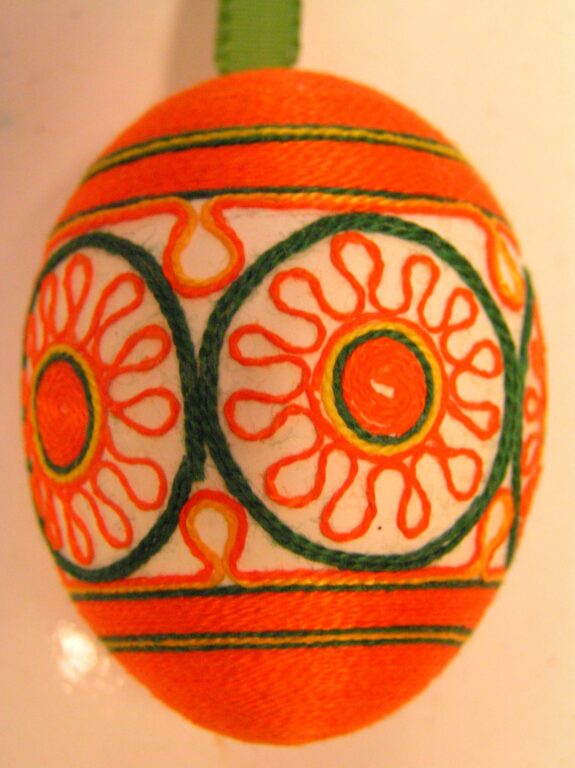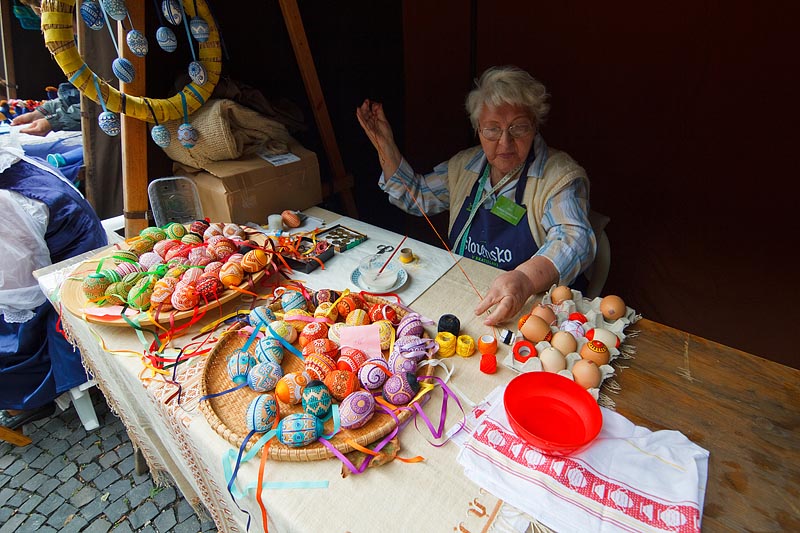She grew up in Moravský Lieskový and the atmosphere of its traditional culture influenced her for a lifetime, even though she spent most of her time in cities. She was exposed to folk art through her grandparents and the traditions of her homeland from an early age. In the immediate vicinity of their family lived an "auntie" who spun, wove,...
She grew up in Moravský Lieskový and the atmosphere of its traditional culture influenced her for a lifetime, even though she spent most of her time in cities. She was exposed to folk art through her grandparents and the traditions of her homeland from an early age. In the immediate vicinity of their family lived an “auntie” who spun, wove, and embroidered. With her friend, they helped her break hemp on the flax comb and gradually became familiar with spinning hemp threads and making folk costumes. The women walking to church on Sundays in those clothes were like models on the catwalk for young Božena Adamicová. To this day, she must admire their sense of moderation, as there was not a single superfluous detail on the products that came from their hands.
She also came across painted eggs in her childhood. In Moravský Lieskový, boys gave them to each other as Easter gifts – cooked, so they could eat them, but already decorated with coloring from a brew of wodehead or other interesting shades achieved by boiling in a brew of red or golden onion. Sometimes the egg was boiled with a leaf, leaving beautiful reverse patterns on it.
After graduating from a pedagogical high school in Trenčín, Božena Adamicová worked as a teacher in Sološnica in Záhorie and in Ivanovská dolina in Melčice in the Trenčín district, later in higher positions at elementary schools in Trenčín. Alongside her job, she remotely studied art education at the University of Trnava, which was also the reason why her relationship with handicrafts and artistic creation persisted into adulthood.
Once when she was learning new techniques in the village of Selec near Trenčín, she encountered eggs coated with marsh grass rush. She was intrigued by the decorating technique and decided to try it out. She obtained rush but did not quite master the process, so she decided to try a seemingly simpler technique of coating with cotton wool instead. Her very first eggs decorated this way in 1986 were featured in the Dorka magazine.
In Moravský Lieskový, hemp threads intended for sewing were dyed in brews. Depending on the strength of the brew, they obtained either a vibrant orange color called fire or, after prolonged soaking, a rust color which they called rusty. Božena Adamicová also uses this traditional color scheme when coating eggs, although the color palette of her cotton wools is richer. She comes up with patterns herself, but many are inspired by the original embroidery, such as the designs on women’s sleeves. She also draws inspiration from later designs embroidered in three colors – black, red, and white or yellow purchased threads. In an effort to achieve the authenticity of the original colors from Moravský Lieskový, she combines white with rust, yellow with white, fire with white, sometimes fire with black, or rusty with black.
She is inspired by plant motifs (e.g., the bloom of butterbur) but also incorporates geometric patterns. As a decorative element, she skillfully uses empty lines and cleverly arranges related colors, creating a flowing effect in their combination. Another unique feature of her eggs is the grouping of cotton wools that creates a kinetic impression. She places two to three pearls at a time, with the third forming a line.
The blown-out egg is painted with diluted white adhesive paste. After drying, she thinly applies adhesive paste with a brush to the area she wants to coat and applies cotton wool to it. To shape it well, the adhesive must not saturate the cotton wool. Eggs can be held only on a dry surface during work, which is why she decorates up to ten eggs at a time. For some patterns, she marks a central line with a pencil, from which the cotton wool seems to flow on its own.
In 1997, she began cooperating with the Folk Art Production Center (ÚĽUV). In 2000, she published her knowledge about folk clothing in Moravský Lieskový in the book “Folk Textiles and Clothing in Moravský Lieskový.” She does not keep the secret of her cotton wool-coated eggs to herself. In Moravský Lieskový and Bratislava, she led handicraft workshops for children and women that included egg decorating with cotton wool.
In 2010, she was awarded the title of Master of Folk Artistic Production for preserving and developing the original technique of coating eggs with cotton wool.
(Source: Čechmánková, N.: Božena Adamicová – embroidered Easter eggs. In: Craft, Art, Design. 12, 2011, no. 1, pp. 24 – 25.).




















